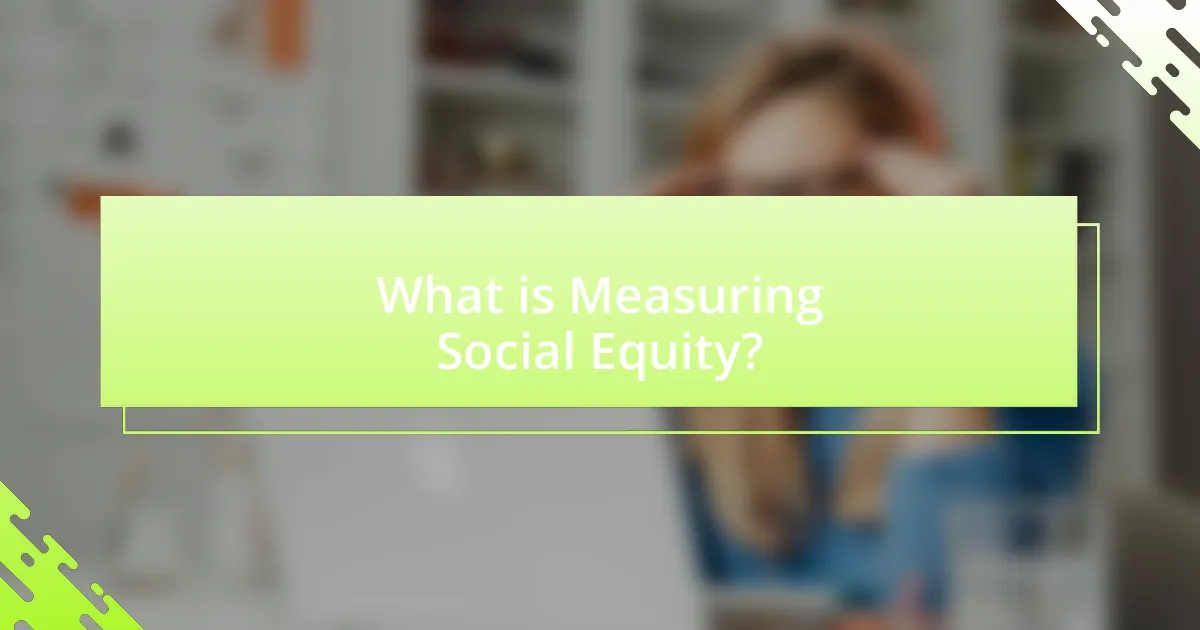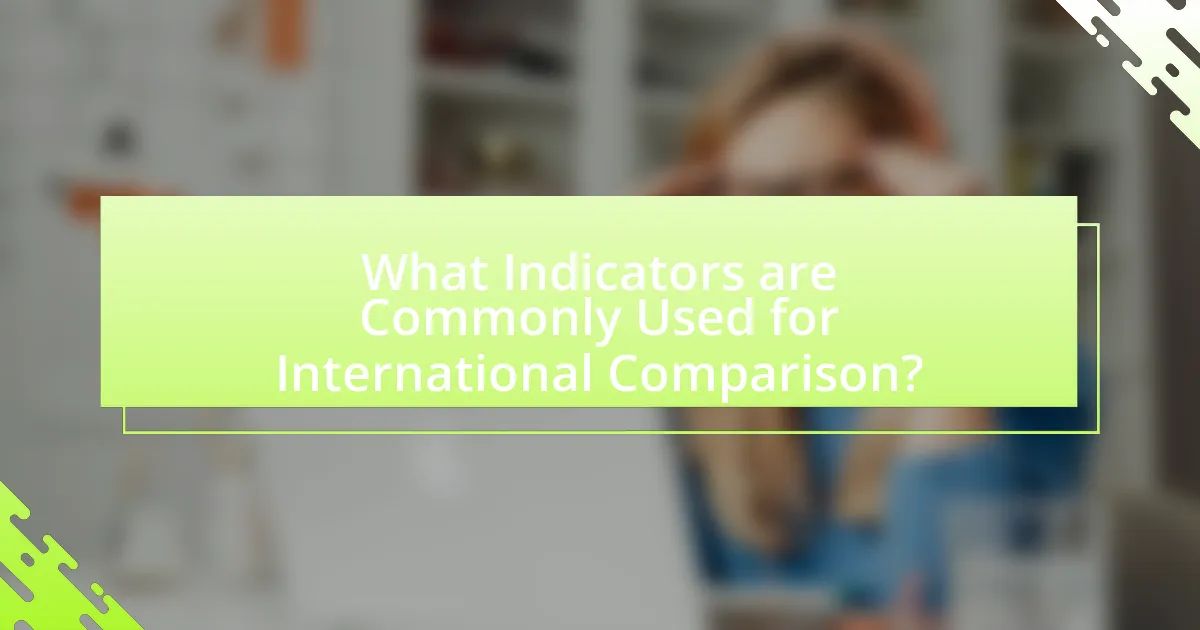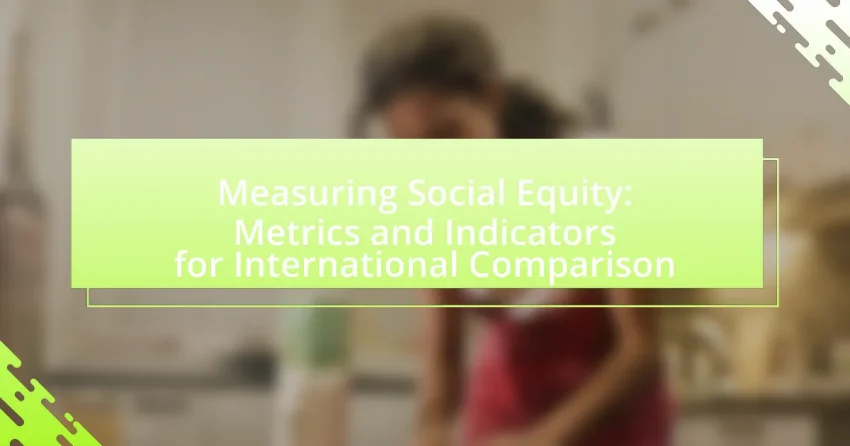Measuring social equity involves assessing fairness in the distribution of resources, opportunities, and privileges within society, utilizing various metrics such as the Gini coefficient and the Human Development Index (HDI). This article explores the importance of measuring social equity, its implications for society and economic development, and the key concepts and metrics used in this assessment. It also examines how different countries approach social equity measurement, the challenges faced in international comparisons, and best practices for enhancing equity metrics. By analyzing these aspects, the article aims to provide a comprehensive understanding of social equity and its significance in promoting social justice and sustainable development.

What is Measuring Social Equity?
Measuring social equity refers to the assessment of fairness and justice in the distribution of resources, opportunities, and privileges within a society. This process involves analyzing various metrics and indicators that reflect disparities in access to education, healthcare, employment, and housing among different demographic groups. For instance, the use of the Gini coefficient, which quantifies income inequality, serves as a concrete example of how social equity can be measured. Additionally, the Human Development Index (HDI) incorporates factors such as life expectancy and education levels to provide a broader understanding of social equity across nations. These metrics enable policymakers and researchers to identify inequities and develop strategies to promote social justice.
Why is Measuring Social Equity Important?
Measuring social equity is important because it provides a framework for assessing fairness and justice within societies. This assessment allows policymakers to identify disparities in access to resources, opportunities, and rights among different demographic groups. For instance, the World Bank’s 2021 report highlights that countries with higher social equity tend to experience lower levels of poverty and improved economic growth. By quantifying social equity through metrics and indicators, stakeholders can implement targeted interventions to address inequalities, ultimately fostering social cohesion and sustainable development.
What are the implications of social equity on society?
Social equity significantly impacts society by promoting fairness and justice in resource distribution, which leads to improved social cohesion and stability. When social equity is prioritized, marginalized groups gain access to essential services such as education, healthcare, and employment opportunities, thereby reducing poverty and inequality. For instance, research from the World Bank indicates that equitable access to education can increase economic productivity by up to 20%. Furthermore, societies that embrace social equity often experience lower crime rates and enhanced public health outcomes, as equitable conditions foster a sense of belonging and community engagement.
How does social equity impact economic development?
Social equity significantly impacts economic development by fostering inclusive growth and reducing disparities. When social equity is prioritized, marginalized groups gain access to resources, education, and employment opportunities, which enhances their economic participation. For instance, research by the World Bank indicates that reducing income inequality can lead to higher economic growth rates, as equitable access to education and job opportunities increases overall productivity. Furthermore, regions that implement policies promoting social equity often experience improved social cohesion and stability, which are essential for sustainable economic development.
What are the key concepts in Social Equity Measurement?
Key concepts in Social Equity Measurement include fairness, access, outcomes, and participation. Fairness refers to the equitable distribution of resources and opportunities among different social groups. Access emphasizes the ability of individuals to obtain essential services and benefits, such as education and healthcare, regardless of their socioeconomic status. Outcomes focus on the results of policies and programs, assessing whether they effectively reduce disparities among populations. Participation highlights the importance of involving diverse communities in decision-making processes to ensure that their needs and perspectives are considered. These concepts are essential for evaluating social equity across various contexts and informing policy development.
What is the definition of social equity?
Social equity is defined as the fair distribution of resources, opportunities, and privileges within a society, ensuring that all individuals have access to the same rights and benefits regardless of their background. This concept emphasizes the importance of addressing systemic inequalities and promoting inclusivity, which is essential for fostering social justice. Research indicates that societies with higher levels of social equity tend to experience improved economic performance and social cohesion, as evidenced by studies from the Organisation for Economic Co-operation and Development (OECD) that highlight the correlation between equity and overall societal well-being.
How do equity and equality differ in measurement?
Equity and equality differ in measurement primarily in their focus on outcomes versus inputs. Equality measures the uniform distribution of resources or opportunities among individuals, ensuring everyone receives the same amount regardless of their circumstances. In contrast, equity assesses the fairness of resource distribution based on individual needs and circumstances, aiming to achieve equal outcomes by providing varying levels of support. For example, in education, equality would mean every student receives the same textbook, while equity would mean providing additional resources to students from disadvantaged backgrounds to ensure they achieve similar educational outcomes. This distinction is crucial for accurately assessing social equity, as it highlights the need for tailored approaches to address systemic disparities.

What Metrics are Used to Measure Social Equity?
Metrics used to measure social equity include income distribution, access to education, healthcare availability, and employment opportunities. These metrics assess how resources and opportunities are distributed across different demographic groups, highlighting disparities. For instance, the Gini coefficient quantifies income inequality, while the Human Development Index evaluates education and health outcomes. Additionally, the Social Progress Index incorporates various indicators, such as access to basic needs and personal rights, to provide a comprehensive view of social equity across nations.
What are the primary metrics for assessing social equity?
The primary metrics for assessing social equity include income distribution, access to education, healthcare availability, and employment opportunities. Income distribution is often measured using the Gini coefficient, which quantifies income inequality within a population. Access to education can be evaluated through enrollment rates and educational attainment levels, highlighting disparities in educational opportunities. Healthcare availability is assessed by examining access to medical services and health outcomes across different demographics. Employment opportunities are analyzed through unemployment rates and job accessibility, reflecting economic equity. These metrics provide a comprehensive framework for understanding social equity across various contexts.
How is income distribution measured in social equity?
Income distribution in social equity is measured using various metrics such as the Gini coefficient, income quintiles, and the Lorenz curve. The Gini coefficient quantifies income inequality on a scale from 0 to 1, where 0 represents perfect equality and 1 indicates maximum inequality; for instance, a Gini coefficient of 0.30 suggests a moderate level of income inequality. Income quintiles divide the population into five equal parts based on income, allowing for comparison of the share of total income received by each group, which highlights disparities in wealth distribution. The Lorenz curve visually represents income distribution, showing the proportion of total income earned by cumulative percentages of the population, thus illustrating the degree of inequality. These methods provide concrete data for assessing social equity across different regions and populations.
What role does access to education play in social equity metrics?
Access to education is a critical component of social equity metrics, as it directly influences individuals’ opportunities for economic mobility and social participation. Research indicates that equitable access to quality education reduces disparities in income and employment, thereby fostering a more inclusive society. For instance, the World Bank reports that each additional year of schooling can increase an individual’s income by up to 10%, highlighting the economic benefits of educational access. Furthermore, studies show that regions with higher educational attainment levels tend to exhibit lower rates of poverty and inequality, reinforcing the link between education and social equity.
How do different countries approach social equity measurement?
Different countries approach social equity measurement through various frameworks and indicators tailored to their specific social, economic, and political contexts. For instance, the United States utilizes the Social Progress Index, which assesses social equity through dimensions like access to education and healthcare, while Scandinavian countries often emphasize welfare state metrics that focus on income equality and social mobility. In contrast, countries like Brazil employ the Gini coefficient to measure income inequality, reflecting their unique socio-economic challenges. These diverse methodologies highlight the importance of contextual factors in shaping how social equity is defined and measured across different nations.
What are the variations in metrics used across different nations?
Variations in metrics used across different nations include differences in definitions, data collection methods, and indicators for measuring social equity. For instance, the United States often utilizes the Gini coefficient to assess income inequality, while Scandinavian countries may focus on the Human Development Index, which incorporates health, education, and income. Additionally, some nations prioritize subjective well-being measures, such as life satisfaction surveys, while others emphasize objective indicators like poverty rates. These variations reflect cultural, economic, and political contexts that influence how social equity is perceived and measured globally.
How do cultural factors influence social equity indicators?
Cultural factors significantly influence social equity indicators by shaping societal values, norms, and behaviors that determine access to resources and opportunities. For instance, cultures that prioritize collectivism may promote policies that enhance social welfare and reduce inequality, while individualistic cultures might emphasize personal responsibility, potentially leading to greater disparities. Research shows that countries with strong cultural emphasis on egalitarianism, such as Scandinavian nations, often exhibit higher social equity indicators, including lower income inequality and better access to education and healthcare. This correlation highlights how cultural attitudes directly impact the measurement and outcomes of social equity across different societies.

What Indicators are Commonly Used for International Comparison?
Commonly used indicators for international comparison include Gross Domestic Product (GDP), Human Development Index (HDI), Gini coefficient, and poverty rates. GDP measures the economic performance of a country, while HDI assesses overall well-being through health, education, and income. The Gini coefficient quantifies income inequality, with values ranging from 0 (perfect equality) to 1 (maximum inequality). Poverty rates indicate the percentage of the population living below the national poverty line, providing insight into economic disparities. These indicators are widely recognized and utilized by organizations such as the World Bank and the United Nations for comparative analysis across nations.
What are the most recognized indicators for international social equity comparison?
The most recognized indicators for international social equity comparison include the Gini coefficient, Human Development Index (HDI), and the Multidimensional Poverty Index (MPI). The Gini coefficient measures income inequality within a population, with values ranging from 0 (perfect equality) to 1 (perfect inequality), providing a clear metric for assessing economic disparities. The Human Development Index combines indicators of life expectancy, education, and per capita income to evaluate overall well-being and development across countries. The Multidimensional Poverty Index assesses poverty through various deprivations in health, education, and living standards, offering a comprehensive view of social equity beyond income alone. These indicators are widely used in reports by organizations such as the United Nations and the World Bank, reinforcing their validity in international comparisons of social equity.
How is the Human Development Index related to social equity?
The Human Development Index (HDI) is directly related to social equity as it measures a country’s average achievements in health, education, and income, which are essential components of equitable development. HDI reflects disparities in these dimensions, highlighting inequalities in access to resources and opportunities among different social groups. For instance, countries with high HDI scores typically exhibit lower levels of income inequality and better access to education and healthcare, indicating a more equitable distribution of resources. Conversely, lower HDI scores often correlate with significant social inequities, as seen in nations where wealth is concentrated among a small elite, limiting opportunities for the broader population. This relationship underscores the importance of HDI as a tool for assessing not just development, but also the fairness of that development across different segments of society.
What is the significance of the Gini coefficient in measuring equity?
The Gini coefficient is significant in measuring equity as it quantifies income distribution within a population, providing a clear numerical representation of inequality. This coefficient ranges from 0 to 1, where 0 indicates perfect equality (everyone has the same income) and 1 signifies maximum inequality (one person has all the income). The Gini coefficient allows for comparisons across different countries and regions, facilitating the assessment of social equity over time. For instance, according to the World Bank, countries with lower Gini coefficients, such as Denmark and Sweden, exhibit more equitable income distributions compared to those with higher coefficients, like South Africa and Brazil, which highlights disparities in wealth and social equity.
How can social equity indicators be effectively compared internationally?
Social equity indicators can be effectively compared internationally by standardizing measurement frameworks and utilizing common metrics across different countries. This approach allows for the alignment of data collection methods, ensuring that indicators such as income inequality, access to education, and healthcare availability are assessed using similar criteria. For instance, the OECD’s Better Life Index employs standardized indicators that facilitate cross-country comparisons, providing a reliable basis for evaluating social equity. Additionally, organizations like the United Nations Development Programme utilize the Human Development Index, which incorporates various dimensions of equity, further enabling international comparisons. These standardized frameworks enhance the validity and reliability of social equity assessments across diverse contexts.
What methodologies are used for international comparisons of social equity?
International comparisons of social equity utilize methodologies such as the Human Development Index (HDI), Gini coefficient, and Multidimensional Poverty Index (MPI). The HDI measures average achievement in key dimensions of human development, including health, education, and standard of living, providing a composite score for countries. The Gini coefficient quantifies income inequality within a population, where a score of 0 represents perfect equality and a score of 1 indicates maximum inequality. The MPI assesses poverty through multiple deprivations in health, education, and living standards, offering a broader perspective on social equity beyond income alone. These methodologies are validated by their widespread use in reports by organizations like the United Nations Development Programme and the World Bank, which rely on these metrics to analyze and compare social equity across nations.
How do data collection practices affect international equity comparisons?
Data collection practices significantly influence international equity comparisons by determining the accuracy, consistency, and comprehensiveness of the data used for analysis. For instance, variations in methodologies, such as survey design and sampling techniques, can lead to discrepancies in reported outcomes across countries. A study by the World Bank highlights that inconsistent definitions of poverty and inequality metrics can result in misleading comparisons, as seen in the differing poverty thresholds applied in various nations. Furthermore, the frequency and scope of data collection can affect the timeliness and relevance of the information, impacting policymakers’ ability to address equity issues effectively. Thus, robust and standardized data collection practices are essential for reliable international equity assessments.
What are the challenges in measuring social equity across countries?
Measuring social equity across countries faces significant challenges due to variations in definitions, data availability, and cultural contexts. Different countries may interpret social equity differently, leading to inconsistencies in metrics used for assessment. For instance, while some nations prioritize income equality, others may focus on access to education or healthcare as indicators of social equity. Additionally, data availability can be a major hurdle; many countries lack comprehensive datasets that capture the nuances of social equity, making cross-country comparisons difficult. Furthermore, cultural differences influence perceptions of fairness and justice, complicating the establishment of universal indicators. These factors collectively hinder the ability to accurately measure and compare social equity on a global scale.
What limitations exist in current social equity metrics?
Current social equity metrics face several limitations, including a lack of standardization, insufficient data granularity, and an over-reliance on quantitative measures. The absence of universally accepted definitions and frameworks leads to inconsistencies in how equity is measured across different contexts. For instance, various organizations may use different indicators to assess social equity, making comparisons challenging. Additionally, many metrics do not capture the nuanced experiences of marginalized communities, as they often rely on aggregated data that can obscure disparities within subgroups. Research by the Urban Institute highlights that traditional metrics may overlook qualitative factors, such as community engagement and lived experiences, which are crucial for a comprehensive understanding of social equity.
How can biases in data affect social equity assessments?
Biases in data can significantly distort social equity assessments by misrepresenting the needs and conditions of marginalized groups. When data collection methods favor certain demographics or exclude others, the resulting analysis may overlook systemic inequalities, leading to policies that do not address the actual disparities faced by disadvantaged populations. For instance, a study by the Urban Institute found that biased data can lead to misallocation of resources, as decisions based on incomplete or skewed information fail to reflect the true socio-economic challenges of underrepresented communities. This misrepresentation can perpetuate existing inequities rather than promote social justice.
What best practices can enhance the measurement of social equity?
Best practices that can enhance the measurement of social equity include the use of disaggregated data, stakeholder engagement, and the application of equity-focused indicators. Disaggregated data allows for a more nuanced understanding of disparities among different demographic groups, revealing inequities that aggregate data may obscure. Stakeholder engagement ensures that the voices of marginalized communities are included in the measurement process, leading to more relevant and accurate assessments. Additionally, applying equity-focused indicators, such as access to education, healthcare, and employment opportunities, provides concrete metrics that can be compared internationally, facilitating a clearer understanding of social equity across different contexts. These practices are supported by research indicating that comprehensive data collection and community involvement significantly improve the accuracy and relevance of social equity measurements.
How can stakeholders collaborate to improve social equity metrics?
Stakeholders can collaborate to improve social equity metrics by establishing partnerships that focus on data sharing, community engagement, and joint resource allocation. Collaborative efforts, such as public-private partnerships, enable stakeholders to pool resources and expertise, leading to more comprehensive data collection and analysis. For instance, the Urban Institute’s research highlights that collaborative data initiatives can enhance the accuracy of social equity assessments by incorporating diverse community perspectives and needs. By working together, stakeholders can create standardized metrics that reflect the realities of marginalized populations, ultimately leading to more effective policy interventions and improved social equity outcomes.
What innovative approaches can be adopted for better equity measurement?
Innovative approaches for better equity measurement include the use of big data analytics, participatory methods, and intersectional frameworks. Big data analytics allows for the analysis of large datasets to identify disparities in real-time, enhancing the accuracy of equity assessments. Participatory methods involve engaging communities in the measurement process, ensuring that the metrics reflect the lived experiences of diverse populations. Intersectional frameworks consider multiple social identities, such as race, gender, and socioeconomic status, to provide a more nuanced understanding of equity. These approaches are supported by studies indicating that traditional metrics often overlook critical dimensions of inequality, thus necessitating more comprehensive methodologies for effective equity measurement.
